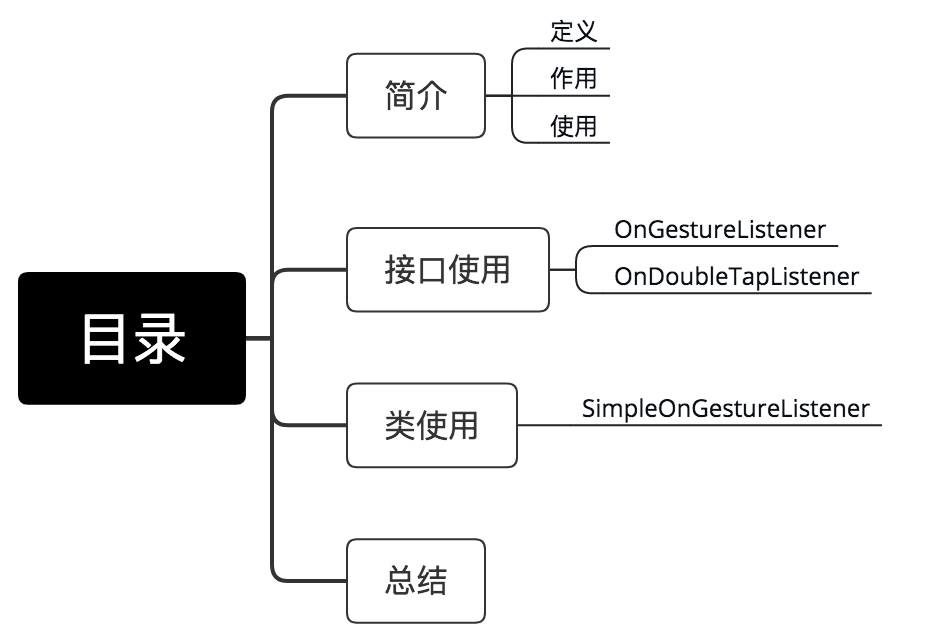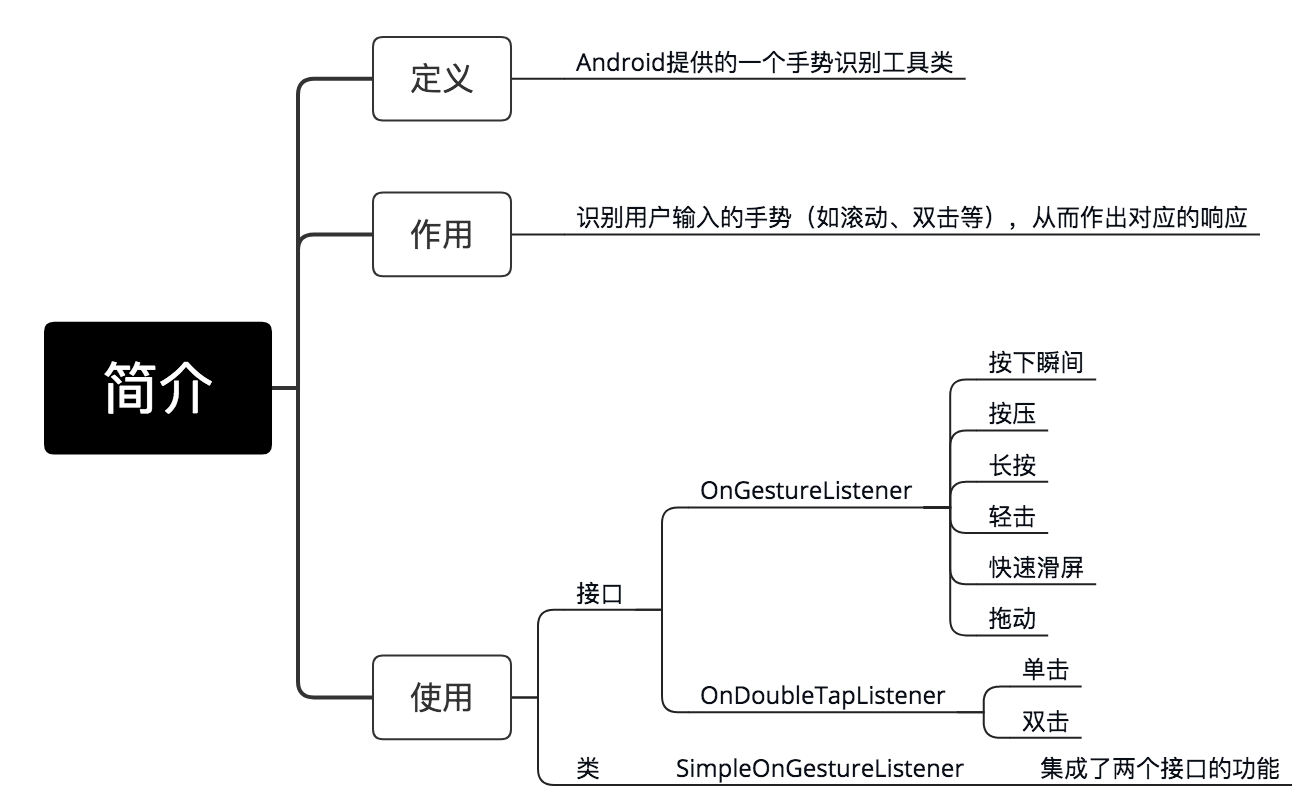目录

简介

下面,我将结合实例,详细介绍GestureDetector的使用接口 & 使用类。
接口1:OnGestureListener
1. 作用
检测用户在屏幕的以下操作:按下瞬间、按压、长按、轻击、快速滑屏、拖动
2. 使用步骤
// 步骤1:创建手势检测器实例 & 传入OnGestureListener接口(需要复写对应方法)
// 构造函数有3个,常用的是第二个
// 1\. GestureDetector gestureDetector=new GestureDetector(GestureDetector.OnGestureListener listener);
// 2\. GestureDetector gestureDetector=new GestureDetector(Context context,GestureDetector.OnGestureListener listener);
// 3\. GestureDetector gestureDetector=new GestureDetector(Context context,GestureDetector.SimpleOnGestureListener listener);
GestureDetector mGestureDetector = new GestureDetector(this, new GestureDetector.OnGestureListener() {
// 1\. 用户轻触触摸屏
public boolean onDown(MotionEvent e) {
Log.i("MyGesture", "onDown");
return false;
}
// 2\. 用户轻触触摸屏,尚未松开或拖动
// 与onDown()的区别:无松开 / 拖动
// 即:当用户点击的时,onDown()就会执行,在按下的瞬间没有松开 / 拖动时onShowPress就会执行
public void onShowPress(MotionEvent e) {
Log.i("MyGesture", "onShowPress");
}
// 3\. 用户长按触摸屏
public void onLongPress(MotionEvent e) {
Log.i("MyGesture", "onLongPress");
}
// 4\. 用户轻击屏幕后抬起
public boolean onSingleTapUp(MotionEvent e) {
Log.i("MyGesture", "onSingleTapUp");
return true;
}
// 5\. 用户按下触摸屏 & 拖动
public boolean onScroll(MotionEvent e1, MotionEvent e2,
float distanceX, float distanceY) {
Log.i("MyGesture", "onScroll:");
return true;
}
// 6\. 用户按下触摸屏、快速移动后松开
// 参数:
// e1:第1个ACTION_DOWN MotionEvent
// e2:最后一个ACTION_MOVE MotionEvent
// velocityX:X轴上的移动速度,像素/秒
// velocityY:Y轴上的移动速度,像素/秒
public boolean onFling(MotionEvent e1, MotionEvent e2, float velocityX,
float velocityY) {
Log.i("MyGesture", "onFling");
return true;
}
});
// 步骤2-1:让某个View检测手势 - 重写View的onTouch函数,将View的触屏事件交给GestureDetector处理,从而对用户手势作出响应
View.setOnTouchListener(new View.OnTouchListener() {
@Override
public boolean onTouch(View v, MotionEvent event) {
mGestureDetector.onTouchEvent(event);
return true; // 注:返回true才能完整接收触摸事件
}
});
// 步骤2-2:让某个Activity检测手势:重写Activity的dispatchTouchEvent函数,将触屏事件交给GestureDetector处理,从而对用户手势作出响应
@Override
public boolean dispatchTouchEvent(MotionEvent ev) {
mGestureDetector.onTouchEvent(ev); // 让GestureDetector响应触碰事件
super.dispatchTouchEvent(ev); // 让Activity响应触碰事件
return false;
}
3. 实例说明
现在对一个TextView进行手势检测
activity_main.xml
<?xml version="1.0" encoding="utf-8"?>
<LinearLayout xmlns:android="http://schemas.android.com/apk/res/android"
android:orientation="vertical"
xmlns:tools="http://schemas.android.com/tools"
android:layout_width="match_parent"
android:layout_height="match_parent"
tools:context=".MainActivity"
>
<TextView
android:id="@+id/textView"
android:layout_width="match_parent"
android:layout_height="600dp"
android:text="carson_ho Test"
android:textAppearance="?android:attr/textAppearanceLarge" />
</LinearLayout>
MainActivity.java
public class MainActivity extends AppCompatActivity {
TextView mTextView;
GestureDetector mGestureDetector;
@Override
protected void onCreate(Bundle savedInstanceState) {
super.onCreate(savedInstanceState);
setContentView(R.layout.activity_main);
// 步骤1:创建手势检测器实例 & 传入OnGestureListener接口(需要复写对应方法)
mGestureDetector = new GestureDetector(this, new GestureDetector.OnGestureListener() {
// 1\. 用户轻触触摸屏
public boolean onDown(MotionEvent e) {
Log.i("MyGesture", "onDown");
return false;
}
// 2\. 用户轻触触摸屏,尚未松开或拖动
// 与onDown()的区别:无松开 / 拖动
// 即:当用户点击的时,onDown()就会执行,在按下的瞬间没有松开 / 拖动时onShowPress就会执行
public void onShowPress(MotionEvent e) {
Log.i("MyGesture", "onShowPress");
}
// 3\. 用户长按触摸屏
public void onLongPress(MotionEvent e) {
Log.i("MyGesture", "onLongPress");
}
// 4\. 用户轻击屏幕后抬起
public boolean onSingleTapUp(MotionEvent e) {
Log.i("MyGesture", "onSingleTapUp");
return true;
}
// 5\. 用户按下触摸屏 & 拖动
public boolean onScroll(MotionEvent e1, MotionEvent e2,
float distanceX, float distanceY) {
Log.i("MyGesture", "onScroll:");
return true;
}
// 6\. 用户按下触摸屏、快速移动后松开
// 参数:
// e1:第1个ACTION_DOWN MotionEvent
// e2:最后一个ACTION_MOVE MotionEvent
// velocityX:X轴上的移动速度,像素/秒
// velocityY:Y轴上的移动速度,像素/秒
public boolean onFling(MotionEvent e1, MotionEvent e2, float velocityX,
float velocityY) {
Log.i("MyGesture", "onFling");
return true;
}
});
// 步骤2:让TextView检测手势:重写View的onTouch函数,将触屏事件交给GestureDetector处理,从而对用户手势作出响应
mTextView = (TextView) findViewById(R.id.textView);
mTextView.setOnTouchListener(new View.OnTouchListener() {
@Override
public boolean onTouch(View v, MotionEvent event) {
mGestureDetector.onTouchEvent(event);
return false;
}
});
}
}
4. 示意图
我在屏幕作出一系列手势进行测试
接口2:OnDoubleTapListener
1. 作用
检测用户单击、双击屏幕
2. 使用步骤
// 步骤1:创建手势检测器实例
// 注:使用OnDoubleTapListener接口时,需要使用GestureDetector,而GestureDetector的创建则必须传入OnGestureListener接口
// 所以在使用OnDoubleTapListener接口时,也必须实现OnGestureListener接口
// 构造函数有3个,常用的是第二个
// 1\. GestureDetector gestureDetector=new GestureDetector(GestureDetector.OnGestureListener listener);
// 2\. GestureDetector gestureDetector=new GestureDetector(Context context,GestureDetector.OnGestureListener listener);
// 3\. GestureDetector gestureDetector=new GestureDetector(Context context,GestureDetector.SimpleOnGestureListener listener);
GestureDetector mGestureDetector = new GestureDetector(this, new GestureDetector.OnGestureListener() {
// 1\. 用户轻触触摸屏
public boolean onDown(MotionEvent e) {
Log.i("MyGesture", "onDown");
return false;
}
// 2\. 用户轻触触摸屏,尚未松开或拖动
// 与onDown()的区别:无松开 / 拖动
// 即:当用户点击的时,onDown()就会执行,在按下的瞬间没有松开 / 拖动时onShowPress就会执行
public void onShowPress(MotionEvent e) {
Log.i("MyGesture", "onShowPress");
}
// 3\. 用户长按触摸屏
public void onLongPress(MotionEvent e) {
Log.i("MyGesture", "onLongPress");
}
// 4\. 用户轻击屏幕后抬起
public boolean onSingleTapUp(MotionEvent e) {
Log.i("MyGesture", "onSingleTapUp");
return true;
}
// 5\. 用户按下触摸屏 & 拖动
public boolean onScroll(MotionEvent e1, MotionEvent e2,
float distanceX, float distanceY) {
Log.i("MyGesture", "onScroll:");
return true;
}
// 6\. 用户按下触摸屏、快速移动后松开
// 参数:
// e1:第1个ACTION_DOWN MotionEvent
// e2:最后一个ACTION_MOVE MotionEvent
// velocityX:X轴上的移动速度,像素/秒
// velocityY:Y轴上的移动速度,像素/秒
public boolean onFling(MotionEvent e1, MotionEvent e2, float velocityX,
float velocityY) {
Log.i("MyGesture", "onFling");
return true;
}
});
// 步骤2:创建 & 设置OnDoubleTapListener接口实现类
mGestureDetector.setOnDoubleTapListener(new GestureDetector.OnDoubleTapListener() {
// 1\. 单击事件
// 关于OnDoubleTapListener.onSingleTapConfirmed()和 OnGestureListener.onSingleTapUp()的区别
// onSingleTapConfirmed:再次点击(即双击),则不会执行
// onSingleTapUp:手抬起就会执行
public boolean onSingleTapConfirmed(MotionEvent e) {
Log.i("MyGesture", "onSingleTapConfirmed");
return false;
}
// 2\. 双击事件
public boolean onDoubleTap(MotionEvent e) {
Log.i("MyGesture", "onDoubleTap");
return false;
}
// 3\. 双击间隔中发生的动作
// 指触发onDoubleTap后,在双击之间发生的其它动作,包含down、up和move事件;
public boolean onDoubleTapEvent(MotionEvent e) {
Log.i("MyGesture", "onDoubleTapEvent");
return false;
}
});
// 步骤3-1:让某个View检测手势 - 重写View的onTouch函数,将View的触屏事件交给GestureDetector处理,从而对用户手势作出响应
View.setOnTouchListener(new View.OnTouchListener() {
@Override
public boolean onTouch(View v, MotionEvent event) {
mGestureDetector.onTouchEvent(event);
return true; // 注:返回true才能完整接收触摸事件
}
});
// 步骤3-2:让某个Activity检测手势:重写Activity的dispatchTouchEvent函数,将触屏事件交给GestureDetector处理,从而对用户手势作出响应
@Override
public boolean dispatchTouchEvent(MotionEvent ev) {
mGestureDetector.onTouchEvent(ev); // 让GestureDetector响应触碰事件
super.dispatchTouchEvent(ev); // 让Activity响应触碰事件
return false;
}
3. 实例说明
现在对一个TextView进行手势检测
activity_main.xml
<?xml version="1.0" encoding="utf-8"?>
<LinearLayout xmlns:android="http://schemas.android.com/apk/res/android"
android:orientation="vertical"
xmlns:tools="http://schemas.android.com/tools"
android:layout_width="match_parent"
android:layout_height="match_parent"
tools:context=".MainActivity"
>
<TextView
android:id="@+id/textView"
android:layout_width="match_parent"
android:layout_height="600dp"
android:text="carson_ho Test"
android:textAppearance="?android:attr/textAppearanceLarge" />
</LinearLayout>
MainActivity.java
public class MainActivity extends AppCompatActivity {
TextView mTextView;
GestureDetector mGestureDetector;
@Override
protected void onCreate(Bundle savedInstanceState) {
super.onCreate(savedInstanceState);
setContentView(R.layout.activity_main);
// 步骤1:创建手势检测器实例 & 传入OnGestureListener接口(需要复写对应方法)
mGestureDetector = new GestureDetector(this, new GestureDetector.OnGestureListener() {
// 1\. 用户轻触触摸屏
public boolean onDown(MotionEvent e) {
Log.i("MyGesture1", "onDown");
return false;
}
// 2\. 用户轻触触摸屏,尚未松开或拖动
// 与onDown()的区别:无松开 / 拖动
// 即:当用户点击的时,onDown()就会执行,在按下的瞬间没有松开 / 拖动时onShowPress就会执行
public void onShowPress(MotionEvent e) {
Log.i("MyGesture", "onShowPress");
}
// 3\. 用户长按触摸屏
public void onLongPress(MotionEvent e) {
Log.i("MyGesture", "onLongPress");
}
// 4\. 用户轻击屏幕后抬起
public boolean onSingleTapUp(MotionEvent e) {
Log.i("MyGesture", "onSingleTapUp");
return true;
}
// 5\. 用户按下触摸屏 & 拖动
public boolean onScroll(MotionEvent e1, MotionEvent e2,
float distanceX, float distanceY) {
Log.i("MyGesture", "onScroll:");
return true;
}
// 6\. 用户按下触摸屏、快速移动后松开
// 参数:
// e1:第1个ACTION_DOWN MotionEvent
// e2:最后一个ACTION_MOVE MotionEvent
// velocityX:X轴上的移动速度,像素/秒
// velocityY:Y轴上的移动速度,像素/秒
public boolean onFling(MotionEvent e1, MotionEvent e2, float velocityX,
float velocityY) {
Log.i("MyGesture", "onFling");
return true;
}
});
// 步骤2:创建 & 设置OnDoubleTapListener接口实现类
mGestureDetector.setOnDoubleTapListener(new GestureDetector.OnDoubleTapListener() {
// 1\. 单击事件
// 关于OnDoubleTapListener.onSingleTapConfirmed()和 OnGestureListener.onSingleTapUp()的区别
// onSingleTapConfirmed:再次点击(即双击),则不会执行
// onSingleTapUp:手抬起就会执行
public boolean onSingleTapConfirmed(MotionEvent e) {
Log.i("MyGesture", "onSingleTapConfirmed");
return false;
}
// 2\. 双击事件
public boolean onDoubleTap(MotionEvent e) {
Log.i("MyGesture", "onDoubleTap");
return false;
}
// 3\. 双击间隔中发生的动作
// 指触发onDoubleTap后,在双击之间发生的其它动作,包含down、up和move事件;
public boolean onDoubleTapEvent(MotionEvent e) {
Log.i("MyGesture", "onDoubleTapEvent");
return false;
}
});
// 步骤3:重写View的onTouch函数,将触屏事件交给GestureDetector处理,从而对用户手势作出响应
mTextView = (TextView) findViewById(R.id.textView);
mTextView.setOnTouchListener(new View.OnTouchListener() {
@Override
public boolean onTouch(View v, MotionEvent event) {
mGestureDetector.onTouchEvent(event);
return true;
}
});
}
}
4. 测试效果
日志效果如下
[图片上传失败...(image-1c663d-1595234367877)]
使用类:SimpleOnGestureListener
1. 作用
集成了两个接口的手势检测功能
2. 与上述两个接口的区别
- OnGestureListener和OnDoubleTapListener接口里的函数都是强制必须重写的
- 而SimpleOnGestureListener类的函数则可根据需要选择性复写,因为SimpleOnGestureListener类本身已经实现了这两个接口的所有函数,只是里面全是空的而已
3. 使用步骤
// 步骤1:创建手势检测器实例
// 构造函数有3个,此处用的是第三个
// 1\. GestureDetector gestureDetector=new GestureDetector(GestureDetector.OnGestureListener listener);
// 2\. GestureDetector gestureDetector=new GestureDetector(Context context,GestureDetector.OnGestureListener listener);
// 3\. GestureDetector gestureDetector=new GestureDetector(Context context,GestureDetector.SimpleOnGestureListener listener);
GestureDetector mGestureDetector = new GestureDetector(this, new GestureDetector.SimpleOnGestureListener() {
// OnGestureListener接口的函数
// 1\. 用户轻触触摸屏
public boolean onDown(MotionEvent e) {
Log.i("MyGesture1", "onDown");
return false;
}
// 2\. 用户轻触触摸屏,尚未松开或拖动
// 与onDown()的区别:无松开 / 拖动
// 即:当用户点击的时,onDown()就会执行,在按下的瞬间没有松开 / 拖动时onShowPress就会执行
public void onShowPress(MotionEvent e) {
Log.i("MyGesture", "onShowPress");
}
// 3\. 用户长按触摸屏
public void onLongPress(MotionEvent e) {
Log.i("MyGesture", "onLongPress");
}
// 4\. 用户轻击屏幕后抬起
public boolean onSingleTapUp(MotionEvent e) {
Log.i("MyGesture", "onSingleTapUp");
return true;
}
// 5\. 用户按下触摸屏 & 拖动
public boolean onScroll(MotionEvent e1, MotionEvent e2,
float distanceX, float distanceY) {
Log.i("MyGesture", "onScroll:");
return true;
}
// 6\. 用户按下触摸屏、快速移动后松开
// 参数:
// e1:第1个ACTION_DOWN MotionEvent
// e2:最后一个ACTION_MOVE MotionEvent
// velocityX:X轴上的移动速度,像素/秒
// velocityY:Y轴上的移动速度,像素/秒
public boolean onFling(MotionEvent e1, MotionEvent e2, float velocityX,
float velocityY) {
Log.i("MyGesture", "onFling");
return true;
}
// OnDoubleTapListener的函数
// 1\. 单击事件
// 关于OnDoubleTapListener.onSingleTapConfirmed()和 OnGestureListener.onSingleTapUp()的区别
// onSingleTapConfirmed:再次点击(即双击),则不会执行
// onSingleTapUp:手抬起就会执行
public boolean onSingleTapConfirmed(MotionEvent e) {
Log.i("MyGesture", "onSingleTapConfirmed");
return false;
}
// 2\. 双击事件
public boolean onDoubleTap(MotionEvent e) {
Log.i("MyGesture", "onDoubleTap");
return false;
}
// 3\. 双击间隔中发生的动作
// 指触发onDoubleTap后,在双击之间发生的其它动作,包含down、up和move事件;
public boolean onDoubleTapEvent(MotionEvent e) {
Log.i("MyGesture", "onDoubleTapEvent");
return false;
}
});
// 步骤2-1:让某个View检测手势 - 重写View的onTouch函数,将View的触屏事件交给GestureDetector处理,从而对用户手势作出响应
View.setOnTouchListener(new View.OnTouchListener() {
@Override
public boolean onTouch(View v, MotionEvent event) {
mGestureDetector.onTouchEvent(event);
return true; // 注:返回true才能完整接收触摸事件
}
});
// 步骤2-2:让某个Activity检测手势:重写Activity的dispatchTouchEvent函数,将触屏事件交给GestureDetector处理,从而对用户手势作出响应
@Override
public boolean dispatchTouchEvent(MotionEvent ev) {
mGestureDetector.onTouchEvent(ev); // 让GestureDetector响应触碰事件
super.dispatchTouchEvent(ev); // 让Activity响应触碰事件
return false;
}
4. 实例说明
现在对一个TextView进行手势检测
activity_main.xml
<?xml version="1.0" encoding="utf-8"?>
<LinearLayout xmlns:android="http://schemas.android.com/apk/res/android"
android:orientation="vertical"
xmlns:tools="http://schemas.android.com/tools"
android:layout_width="match_parent"
android:layout_height="match_parent"
tools:context=".MainActivity"
>
<TextView
android:id="@+id/textView"
android:layout_width="match_parent"
android:layout_height="600dp"
android:text="carson_ho Test"
android:textAppearance="?android:attr/textAppearanceLarge" />
</LinearLayout>
MainActivity.java
public class MainActivity extends AppCompatActivity {
TextView mTextView;
GestureDetector mGestureDetector;
@Override
protected void onCreate(Bundle savedInstanceState) {
super.onCreate(savedInstanceState);
setContentView(R.layout.activity_main);
// 步骤1:创建手势检测器实例 & 传入OnGestureListener接口(需要复写对应方法)
mGestureDetector = new GestureDetector(this, new GestureDetector.SimpleOnGestureListener() {
// OnGestureListener接口的函数
// 1\. 用户轻触触摸屏
public boolean onDown(MotionEvent e) {
Log.i("MyGesture1", "onDown");
return false;
}
// 2\. 用户轻触触摸屏,尚未松开或拖动
// 与onDown()的区别:无松开 / 拖动
// 即:当用户点击的时,onDown()就会执行,在按下的瞬间没有松开 / 拖动时onShowPress就会执行
public void onShowPress(MotionEvent e) {
Log.i("MyGesture", "onShowPress");
}
// 3\. 用户长按触摸屏
public void onLongPress(MotionEvent e) {
Log.i("MyGesture", "onLongPress");
}
// 4\. 用户轻击屏幕后抬起
public boolean onSingleTapUp(MotionEvent e) {
Log.i("MyGesture", "onSingleTapUp");
return true;
}
// 5\. 用户按下触摸屏 & 拖动
public boolean onScroll(MotionEvent e1, MotionEvent e2,
float distanceX, float distanceY) {
Log.i("MyGesture", "onScroll:");
return true;
}
// 6\. 用户按下触摸屏、快速移动后松开
// 参数:
// e1:第1个ACTION_DOWN MotionEvent
// e2:最后一个ACTION_MOVE MotionEvent
// velocityX:X轴上的移动速度,像素/秒
// velocityY:Y轴上的移动速度,像素/秒
public boolean onFling(MotionEvent e1, MotionEvent e2, float velocityX,
float velocityY) {
Log.i("MyGesture", "onFling");
return true;
}
// OnDoubleTapListener的函数
// 1\. 单击事件
// 关于OnDoubleTapListener.onSingleTapConfirmed()和 OnGestureListener.onSingleTapUp()的区别
// onSingleTapConfirmed:再次点击(即双击),则不会执行
// onSingleTapUp:手抬起就会执行
public boolean onSingleTapConfirmed(MotionEvent e) {
Log.i("MyGesture", "onSingleTapConfirmed");
return false;
}
// 2\. 双击事件
public boolean onDoubleTap(MotionEvent e) {
Log.i("MyGesture", "onDoubleTap");
return false;
}
// 3\. 双击间隔中发生的动作
// 指触发onDoubleTap后,在双击之间发生的其它动作,包含down、up和move事件;
public boolean onDoubleTapEvent(MotionEvent e) {
Log.i("MyGesture", "onDoubleTapEvent");
return false;
}
});
// 步骤2:重写View的onTouch函数,将触屏事件交给GestureDetector处理,从而对用户手势作出响应
mTextView = (TextView) findViewById(R.id.textView);
mTextView.setOnTouchListener(new View.OnTouchListener() {
@Override
public boolean onTouch(View v, MotionEvent event) {
mGestureDetector.onTouchEvent(event);
return true;
}
});
}
}
5. 测试效果
日志效果如下

至此,关于Android手势识别类GestureDetector类使用讲解完毕。










